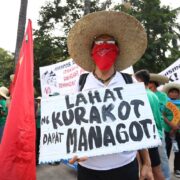50 years of friendship: The ties that bind the Philippines and Peru

Not much is known about Peru in the Philippines, and the same can be said of Peruvians when asked about the Philippines. I find this lamentable not only because of our centuries of shared history, but because I would consider Peru the South American country most similar to the Philippines in terms of culture, cuisine, and the natural warmth of the people. Peruvians are sociable, family-oriented, and are very welcoming to foreign visitors.
The obvious reason for this natural affinity between Filipinos and Peruvians is our shared Spanish heritage. Both Peru and the Philippines were under Spanish rule for more than 280 years, and this shows in the deep religiosity of their people. To this day, Filipinos and Peruvians share the same devotion to Santa Rosa de Lima, after whom the city of Santa Rosa in Laguna and the municipality of Santa Rosa in Nueva Ecija are named.
An obscure fact about the Manila-Acapulco Galleon Trade (1565-1815) was the role Peru’s Callao Port played as a supplementary port to Acapulco, Mexico. Aside from Peruvian products, the trade route brought Peruvian traders to Philippine shores, allowing significant interaction between our peoples during that period. Not surprisingly, the Peruvian currency was accepted as legal tender in the Philippines from 1855 to 1858 to temporarily address the scarcity of Spanish currency at that time.
Peru plays host to the second-largest diaspora of Asians in South America (next only to Brazil). Its Asian diaspora (mainly from China and Japan), has contributed in no small part to Peru’s cosmopolitan nature and embracing culture, including enriching Peru’s world-renowned cuisine with a distinctly Asian flavor.
Every visit to a Peruvian restaurant allows me the opportunity to play my favorite game of naming the Filipino counterpart of a Peruvian dish. I consider the lomo saltado as the perfect substitute for our bistek Tagalog, while the bistec a lo pobre reminds me of our beef tapa. Are you yearning for kinilaw? You can’t go wrong with the ceviche. Another must-try is the mouthwatering sanguche de chicharron that can easily satisfy your craving for lechon kawali.
It is often said that music runs in the veins of every Filipino, and this goes true for Peruvians as well. I recently attended an Apec meeting in Arequipa, Peru, where the guests were treated to a splendid cultural performance showcasing Peruvian folk songs and dances. I couldn’t help noticing how some of the folk dances strongly resemble our Spanish-era dances like the cariñosa and the jota. Another little-known fact is the legacy of Filipino musician Jose Sabas Libornio, who as director general of Peru’s military band, composed the “Marcha de las Banderas” (1897), which is generally considered by Peru as its second national anthem.
In celebration of 50 years of diplomatic relations between the Philippines and Peru, the Philippine Embassy in Chile, under the leadership of Ambassador Celeste Vinzon-Balatbat, conducted a series of commemorative cultural activities in Lima throughout the year, among them the University of the Philippines Rondalla Concert and diplomatic reception at the Centro Cultural Inca Garcilaso, a Filipino film festival, a live cooking demonstration on Peruvian national television featuring Chile-based Filipino chef Miguel Damatac, and a lecture series on historical and cultural ties featuring professors Jorge Bayona and Kristyl Obispado. All these events have served to highlight the deep historical and cultural connections between the Philippines and Peru, and the common elements that remain palpable in our music, visual arts, and cuisine.
Indeed, our shared culture has proven to be a strong and effective foundation for the Philippines and Peru to deepen engagements in other aspects of its bilateral relations in the next 50 years and is yet another manifestation of the power of the Philippines’ inextricable links with Latin America in charting our bilateral relations with our Hispanic cousins.
Jim San Agustin,
consul general,
Embassy of the Philippines,
Santiago, Chile

















